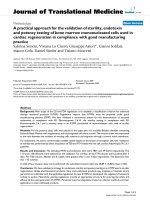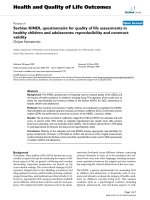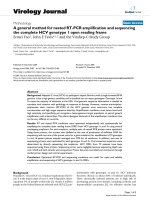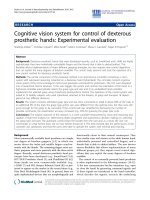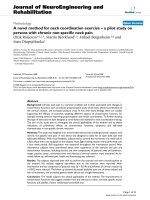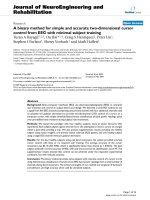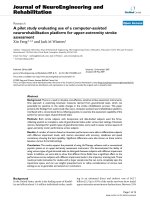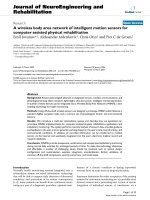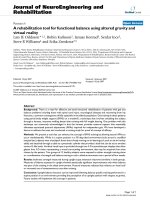Báo cáo hóa học: " A general strategy for synthesis of metal oxide nanoparticles attached on carbon nanomaterials" pptx
Bạn đang xem bản rút gọn của tài liệu. Xem và tải ngay bản đầy đủ của tài liệu tại đây (508.83 KB, 5 trang )
NANO EXPRESS Open Access
A general strategy for synthesis of metal oxide
nanoparticles attached on carbon nanomaterials
Yi Zhao, Jiaxin Li, Chuxin Wu, Lunhui Guan
*
Abstract
We report a general strategy for synthesis of a large variety of metal oxide nanoparticles on different carbon
nanomaterials (CNMs), including single-walled carbon nanotubes, multi-walled carbon nanotubes, and a few-layer
graphene. The approach was based on the π-π interaction between CNMs and modified aromatic organic ligands,
which acted as bridges connecting metal ions and CNMs. Our methods can be applicable for a large variety of
metal ions, thus offering a great potential application.
Introduction
The attachment of nanoparticles (NPs) on carbon nano-
materials (CNMs), including single-walled carbon nano-
tubes (SWNTs), multi-walled carbon nanotubes
(MWNTs), and graphene has attracted great interest, for
the nanocomposites not only co mbine the extraordinary
properties of the NPs and CNMs, but also exhibit some
new p roperties caused by the interaction between them
[1,2]. For examples, when the ligh t-harvesting NPs, such
as TiO
2
, ZnO, CdS, CdSe, were attached on carbon
nanotubes (CNTs) with high conductivity, the photoca-
talytic properties increased dramatically [3-5]. In addi-
tion, CNTs with large surface areas are ideal supporting
materials for catalysts NPs, leading to improvements in
the efficiency of the catalysts [6-8]. A lot of approaches
including assembling pre-synthesized NPs as building
blocks on CNTs, and spontaneous formation of NPs on
CNTs, have been applied to prepare NPs/CNTs [9-14].
The previous reports mainly focused on attaching NPs
on MWNTs by using benzyl alcohol or pyrene deriva-
tives as linkages [15,16]. D evelopment to SWNTs and
graphene,bothwithwell-definedstructures,maypro-
vide important information to explo re the mechanisms
of the enhanced properties of NPs after attached on
CNMs. However, it still remains a challenge to fabricate
uniform NPs/CNMs nanocomposites in a controlled
manner. Here we present a unified strategy for synthesis
of a large v ariety of NPs of metal oxides, including
transition and rare earth metal oxides on SWNTs,
MWNTs, and a few-layer graphene. The s trategy was
based on a noncovalent π-π interaction between deloca-
lized π-electrons of CNMs and aromatic organic com-
pounds, in this case phenylphosphonic acid, which acid
tail can be connected with metal ions. After a hydro-
thermal treatment, the metal oxides NPs were formed
and strongly anchored to the surface of CNMs.
Experimental sections
In our experiments, MWNTs (purity 95%, 20-30 nm in
diameters) were obtained from Shenzhen Nanotech Port
(Shenzhen, China) and used as received, SWNTs (purity
99%, 1.4 nm in diameter) were produc ed by our recent
methods [17], and graphene was produced by a modified
arc-discharged [18]. The experimental scheme is shown
in Figure 1: metal ions were ligated by phenylphospho-
nic acid, which was then connected with CNMs via
noncovalent π-π interaction after sonication, then (NH
2
)
2
CO was added. The solution was t ransferred to an
autoclave and incub ated by a hydrothermal treatment.
The hydrothermal reaction of metal ion s and urea will
result in the formation of metal oxide NPs [19]. The
final preci pitates were filtered and washed several times
with water. The samples were characterized by transmis-
sion electron microscope (TEM), X-ray diffraction
(XRD), and thermogravimetric analysis (TGA). See
Additional file 1 (SI 1) for more experimental details. In
this study, phenylphosphonic acid played a key role on
attaching NPs on CNMs. For comparison, a TEM image
of the typical products without phenylphosphonic acid
was shown in Additional file 1 (SI 2). The part icles size
* Correspondence:
State Key Lab of Structural Chemistry, Fujian Institute of Research on the
Structure of Matter, Chinese Academy of Sciences, YangQiao West Road
155#, Fuzhou, Fujian 350002, P. R. China
Zhao et al . Nanoscale Research Letters 2011, 6:71
/>© 2011 Zhao et al; licensee Springer. This is an Open Access article distributed under the terms of the Creative Commons Attribution
License ( which permits unrestri cted use, distribution, and reproduction in any medium,
provided the original work is properly cited.
was obviously larger and did not connect with SWNTs.
We also checked the intermediate product after sonica-
tion by TGA. The TGA measured the total metal con-
tent with a heating rate of 10°C/min in air. The results
proved that there was weak interaction between metal
ions and CNMs without phenylphosphonic acid. The
TGA residue (mainly i ron oxide) of the products, made
from SWNTs sonicated with only Fe
3+
, was nearly zero.
The results proved that without phenylp hosphonic acid,
the interaction between Fe
3+
and SWNTs was so weak
that the meal ions were easily washed away. On the con-
trary, the resulting residue from SWNTs sonicated with
Fe
3+
was around 20%. The results provided direct evi-
dence that phenylphosphonic acid acted as bridges con-
necting metal ions and CNMs.
Results and discussion
Figure 2 shows TEM images of typical samples of Fe
2
O
3
,
SnO
2
,CeO
2
,andEr
2
O
3
on SWNTs, respectively. The
SWNTs without NPs attachment were seldom observed
by TEM observation. The sizes and loading ratio of NPs
on SWNTs can be controlled by altering temperature,
the ligand, and the initial concentrations of the metal
ions. It is worth to note that the loading ratio in Figure
2 was relatively high, around 80%, resulting in the
agglomerating of the NPs on the CNMs. The interface
between NPs and CNMs is not prominent. When we
decreased the loading ratio, the uniformly dispersed NPs
were appeared on the surface of CNMs. See Additional
file 1 (SI 3) for the SnO
2
onSWNTsasexample.
Inserted images corresponding to their high resolution
(HR) TEM images indicated that the metal oxide NPs
were usually in round shapes binding on SWNTs. HR-
TEM images revealed the detailed structures of these
nanocrystals. Typical HR-TEM image of Fe
2
O
3
nano-
crystals with diameters of approximately 4 nm presents
a crystal lattice of approximately 0.25 nm, corresponding
to (110) planes of a-Fe
2
O
3
. The result was accorded
with XRD pattern shown in Additional file 1 (SI 3). The
regular interplanar spacing of 0.33 nm for SnO
2
,0.27
nm for CeO
2
, was ascribed to (110) planes of SnO
2
,
(200) planes of CeO
2
, respectively. However, as for the
rare earth metal oxide Er
2
O
3
,itdidnotformfinecrys-
talline struc tures in su ch reaction conditions. The result
was confirmed by the powder XRD pattern shown in
Additional file 1 (SI 3). One might expect formation of
crystalline Er
2
O
3
NPs after thermal annealing. The
nanohybrid materials have many potential applications
compa red with the isolated NPs, becau se SWNT s act as
carrier to stabilize NPs, maintaining their integrity. We
selected Fe
2
O
3
/SWNTs as a model case for superior
anode materials of lithium ion batteries.
Figure 3 displays the high reversibility of the electro-
chemical reactions of Fe
2
O
3
/SWNTs nanohybrid over
many charge-discharge cycles and the columbic effi-
ciency. After 100 cycles at 150 mA g
-1
, it still remained
a high reversible capacity of 560 mAh g
-1
,whichwas
significantly higher than that of graphite (372 mAh g
-1
)
and Fe
2
O
3
nanotube (510 mAh g
-1
at 100 mA g
-1
) [20].
Thecolumbicefficiencyofthewhole100cycleswas
around 97%. Our previous results indicated that the
SWNTs produced by our method provided low Li inser-
tation/de-insertation capabilities, around 200 mAh g
-1
[21], so the superior capabilities of Fe
2
O
3
NP/SWNTs
electrode were ascribed to the reactions involving Fe2
+
-Fe3
+
conversions. The performance of the nanocom-
posites was mainly determined by the particle sizes and
loading ratio of the NPs.
Ourmethodwasbasedonπ-π interaction b etween
ligand and CNMs, thus can also be generally applicable
to graphene and MWNTs. Shown in Figure 4 are TEM
images of Fe
2
O
3
,SnO
2
,CeO
2
, and TiO
2
NPs assembled
with a few-layer graphene . The diameters and loading
ratio of NPs were controlled by temperature and the
mole ratio of metal ions to graphene nanosheets. Typi-
cally, the particles are remarkably smaller when depos-
ited on CNMs compared with unanchored phase, since
CNMs can prevent crystal growth during crystallizat ion.
We also succeeded in introducing NPs of different rare
Figure 1 A schematic representation of attaching various
metal oxide NPs on different CNMs.
Zhao et al . Nanoscale Research Letters 2011, 6:71
/>Page 2 of 5
Figure 2 TEM images of various metal oxide NPs of Fe
2
O
3
, SnO
2
, CeO
2
, and Er
2
O
3
on SWNTs.
Figure 3 Cycle performance and columbic efficiency of Fe
2
O
3
/SWNTs nanohybrids with a current density of 150 mA g
-1
.
Zhao et al . Nanoscale Research Letters 2011, 6:71
/>Page 3 of 5
earth metal oxides on MWNTs. See Additional file 1 (SI 5)
for more details.
Conclusion
In summary, we report a general strategy for synthesis
of a large variety of metal oxide NPs on CNMs, includ-
ingSWNTs,MWNTs,andafew-layergraphene.The
approach was base d on the π-π interaction between
CNMs and modified aromatic organic ligands, which
acted as bridges connecting metal ions and CNMs. Our
methods can be applicable for a large variety of metal
ions. By adopting bi-metal or even tri-metal precursors
in a certain mole ratio, composite oxide nanocrystals
with novel st ructures and mult i-function deposited on
different CNMs can be effectively prepared through this
method. The new class of hybrid nanomaterials offers a
great potential application in sustainable energy, envir-
onment, and even biomedicine.
Additional material
Additional file 1: Supporting information. Experimental details, the
proof of π-π interaction between ligand and CNMs, the linkage of NPs
and CNMs, electrochemical measurements and NPs on MWNTs.
Abbreviations
CNMs: carbon nanomaterials; CNTs: carbon nanotubes; MWNTs: multi-walled
carbon nanotubes; NPs: nanoparticles; SWNTs: single-walled carbon
nanotubes; TEM: transmission electron microscope; TGA: thermogravimetric
analysis; XRD: X-ray diffraction.
Acknowledgements
Financial support for this study was provided by Fujian Institute of Research
on the Structure of Matter, Chinese Academy of Sciences (SZD 09003), and
the National Key Project on Basic Research (Grant No. 2009CB939801,
2011CB935904) of China.
Authors’ contributions
YZ carried out experiments, analysed and discussed data and wrote the
paper; JL carried out experiments; CW carried out experiments, LG
Figure 4 TEM images of various metal oxide NPs of Fe
2
O
3
, SnO
2
, CeO
2
, and TiO
2
on a few-layer graphene.
Zhao et al . Nanoscale Research Letters 2011, 6:71
/>Page 4 of 5
conceived, designed and carried out experiments, analysed and discussed
data and wrote the paper.
Competing interests
The authors declare that they have no competing interests.
Received: 25 June 2010 Accepted: 12 January 2011
Published: 12 January 2011
References
1. Eder D: Carbon Nanotube-Inorganic Hybrids. Chem Rev 2010, 110:1348,
and the reference there in.
2. Chu H, Wei L, Cui R, Wang J, Li Y: Carbon nanotubes combined with
inorganic nanomaterials: Preparations and applications. Coord Chem Rev
2010, 254:1117, and the reference there in.
3. Banerjee S, Wong SS: Synthesis and Characterization of Carbon
Nanotube-Nanocrystal Heterostructures. Nano Lett 2002, 2:195.
4. Woan K, Pyrgiotakis G, Sigmund W: Photocatalytic Carbon-Nanotube-TiO2
Composites. Adv Mater 2009, 21:2233.
5. Hungria AB, Juarez BH, Klinke C, Weller H, Midgley PA: 3-D characterization
of CdSe nanoparticles attached to carbon nanotubes. Nano Res 2008,
1:89.
6. Tang JM, Jensen K, Waje M, Li W, Larsen P, Pauley K, Chen Z, Ramesh P,
Itkis P, Yan Y, Haddon RC: High Performance Hydrogen Fuel Cells with
Ultralow Pt Loading Carbon Nanotube Thin Film Catalysts. J Phys Chem C
2007, 111:17901.
7. Wildgoose GG, Banks CE, Compton RG: Metal Nanoparticles and Related
Materials Supported on Carbon Nanotubes: Methods and Applications.
Small 2006, 2:182.
8. Georgakilas V, Gournis D, Tzitzios V, Pasquato L, Guldi DM, Prato M:
Decorating carbon nanotubes with metal or semiconductor
nanoparticles. J Mater Chem 2007, 17:2679.
9. Qu LT, Dai LM: Shape/Size-Controlled Syntheses of Metal Nanoparticles
for Site-Selective Modification of Carbon Nanotubes. J Am Chem Soc
2005, 127:10806.
10. Han WQ, Zettl A: Coating Single-Walled Carbon Nanotubes with Tin
Oxide. Nano Lett 2003, 3:681.
11. Coleman KS, Bailey SR, Fogden S, Green MLH: Functionalization of Single-
Walled Carbon Nanotubes via the Bingel Reaction. J Am Chem Soc 2003,
125:8722.
12. Chu HB, Wang JY, Ding L, Yuan DN, Zhang Y, Liu J, Li Y: Decoration of
Gold Nanoparticles on Surface-Grown Single-Walled Carbon Nanotubes
for Detection of Every Nanotube by Surface-Enhanced Raman
Spectroscopy. J Am Chem Soc 2009, 131:14310.
13. Li J, Tang SB, Lu L, Zeng HC: Preparation of Nanocomposites of Metals,
Metal Oxides, and Carbon Nanotubes via Self-Assembly. J Am Chem Soc
2007, 129:9401.
14. Wang D, Li ZC, Chen LW: Templated Synthesis of Single-Walled Carbon
Nanotube and Metal Nanoparticle Assemblies in Solution. J Am Chem
Soc 2006, 128:15078.
15. Eder D, Windle AH:
Carbon-Inorganic Hybrid Materials: The Carbon-
Nanotube/TiO
2
Interface. Adv Mater 2008, 20:1787.
16. Yang DQ, Hennequin B, Sacher E: XPS Demonstration of π-π Interaction
between Benzyl Mercaptan and Multiwalled Carbon Nanotubes and
Their Use in the Adhesion of Pt Nanoparticles. Chem Mater 2006, 18:5033.
17. Wu CX, Li JX, Dong GF, Guan LH: Removal of Ferromagnetic Metals for
the Large-Scale Purification of Single-Walled Carbon nanotubes. J Phys
Chem C 2009, 113:3612.
18. Wu C, Dong G, Guan L: Production of graphene sheets by a simple
helium arc-discharge. Physica E: Low-dimensional Systems and
Nanostructures 2010, 42:1267.
19. Cao CY, Cui ZM, Chen CQ, Song WG, Cai W: Ceria Hollow Nanospheres
Produced by a Template-Free Microwave-Assisted Hydrothermal Method
for Heavy Metal Ion Removal and Catalysis. J Phys Chem C 2010,
114:9865.
20. Chen J, Xu LN, Li WY, Gou XL: α-Fe
2
O
3
Nanotubes in Gas Sensor and
Lithium-Ion Battery Applications. Adv Mater 2005, 17:582.
21. Li JX, Wu CY, Guan LH: Lithium Insertion/Extraction Properties of
Nanocarbon Materials. J Phys Chem C 2009, 113:18431.
doi:10.1186/1556-276X-6-71
Cite this article as: Zhao et al.: A general strategy for synthesis of metal
oxide nanoparticles attached on carbon nanomaterials. Nanoscale
Research Letters 2011 6:71.
Submit your manuscript to a
journal and benefi t from:
7 Convenient online submission
7 Rigorous peer review
7 Immediate publication on acceptance
7 Open access: articles freely available online
7 High visibility within the fi eld
7 Retaining the copyright to your article
Submit your next manuscript at 7 springeropen.com
Zhao et al . Nanoscale Research Letters 2011, 6:71
/>Page 5 of 5
